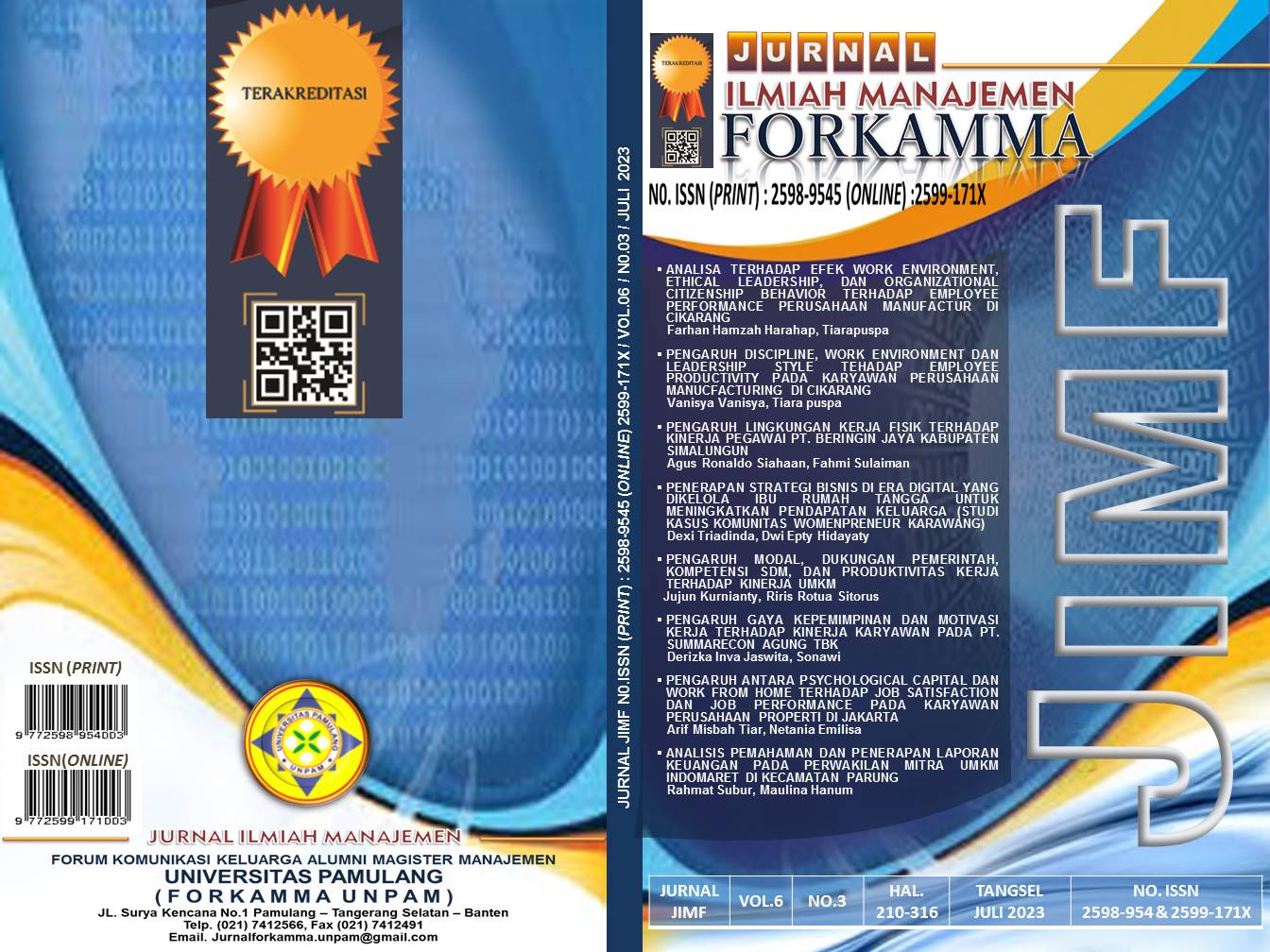Penerapan Strategi Bisnis di Era Digital yang Dikelola Ibu Rumah Tangga Untuk Meningkatkan Pendapatan Keluarga (Studi Kasus Komunitas Womenpreneur Karawang)
DOI:
https://doi.org/10.32493/frkm.v6i3.28638Keywords:
Womenpreneur, Business Strategy, Strategi Bisnis, Era DigitalAbstract
Peranan wanita khususnya ibu rumah tangga di era digital tidak lagi sebagai penonton di dunia bisnis, namun turut berperan dalam memberikan pendapatan bagi keluarga. Tujuan khusus penelitian ini adalah memperoleh gambaran strategi bisnis ibu rumah tangga di Kabupaten Karawang yang termasuk dalam komunitas womanpreneur di Era Digital. Batasan penelitian menggunakan teori strategi bersaing dari Michael Porter. Jenis penelitian ini adalah penelitian deskriptif kualitatif. Informan dalam peneltian terdiri dari tiga pengusaha wanita yang menekuni bisnisnya paling sedikit selama dua tahun kebelakang dan berdomisili di Kabupaten Karawang. Hasil dalam penelitian ini menunjukkan bahwa wanita memiliki peran penting dalam menungkatkan pendapatan keluarga melalui bisnis yang ditekuni. Disamping itu peran digitalisasi semakin memudahkan para pengusaha wanita dalam melakukan pemasaran dalam bisnis.
The role of women, especially housewives in the digital era, is no longer as spectators in the business world, but also plays a role in providing income for the family. The specific objective of this study is to obtain an overview of the business strategies of housewives in Karawang Regency’s who are included in the womanpreneur community in the Digital Age. Limitation of research using competitive strategy theory from Michael Porter. This type of research is a qualitative descriptive research. The informants in the study consisted of three women entrepreneurs who had been in business for at least the past two years and were domiciled in Karawang Regency. The results in this study indicate that women have an important role in increasing family income through the business they are engaged in. Besides that, the role of digitization makes it easier for women entrepreneurs to do marketing in business.
References
Adithia, S., & Jaya, M. P. P. (2021). Strategi Pemasaran Digital Produk Minuman Kopi di Masa Pandemi. Journal of Research on Business and Tourism, 1(1). https://doi.org/10.37535/104001120213
Andriani, A. (2021). Peran Strategi Diferensiasi dalam Meningkatkan Jumlah Wisatawan (Studi Kasus Kampung Coklat Blitar). Al-Muraqabah: Journal of Management and Sharia Business Peran, 1(1).
Ardiyanto, Y. (2019). Memahami Metode Penelitian Kualitatif. Djkn, 2.
Ariyana, R. Y., Haryani, P., & Fatkhiyah, E. (2021). Pemanfaatan Marketplace Media Sosial Sebagai Sarana Promosi Produk Umkm Pada Kelompok Informasi Masyarakat Kabupaten …. Jurnal Dharma Bakti, 4(1).
Indarti, D., & Susanti, E. D. (2021). Analisa Porter Five Force Dalam Upaya Meningkatkan Strategi Bersaing. Jurnal Revolusi Indonesia, 1(6).
Kadim, A., & Sunardi, N. (2022). Financial Management System (QRIS) based on UTAUT Model Approach in Jabodetabek. International Journal of Artificial Intelligence Research, 6(1).
Lesmana, R., & Susanti, N. (2018). ANALISA STRATEGI BERSAING PT. GARUDA INDONESIA TBK. (PERSERO). Jurnal Pemasaran Kompetitif, 1(3). https://doi.org/10.32493/jpkpk.v1i3.1145
Lesmana, R., Sutarman, A., & Sunardi, N. Building A Customer Loyalty Through Service Quality Mediated by Customer Satisfaction. American Journal of Humanities and Social Sciences Research (AJHSSR), 5(3), 38-45
Lesmana, R., & Sunardi, N. (2021). Futuristic Leadership Through PEKA Analysis Approach. HUMANIS (Humanities, Management and Science Proceedings), 2(1).
Saldanha, E. D. E. S. (2018). Peran strategi bisnis dalam memediasi hubungan antara persaingan industri dengan kinerja industri. Dissertation.
Saul, E. Y. (2019). Strategi Bersaing Dan Strategi Bertahan Pada Industri Mikro Dan Kecil Bakpia Pathok Di Kecamatan Ngampilan Yogyakarta 2015. Journal of Chemical Information and Modeling, 53(9).
Sidharta, I., & Sidh, R. (2014). Pengukuran Persepsi Manfaat Dan Persepsi Kemudahan Terhadap Sikap Serta Dampaknya Atas Penggunaan Ulang Online Shopphing Pada E-Commerce. Jurnal Computech & Bisnis, 8(2).
Studi, P., Universitas, M., & Parahyangan, K. (2016). Strategi Diferensiasi sebagai Alat untuk Memenangkan Persaingan pada Industri Kreatif di Bandung. Bina Ekonomi, 20(1).
Suhono, A., Wahyuni, S., & Widodo, J. (2020). Analisis strategi bersaing pada industri kerajinan marmer di kabupaten tulungagung. Jurnal Pendidikan Ekonomi, 14(2).
Sunardi, N., & Tatariyanto, F. . (2023). The Impact of the Covid-19 Pandemic and Fintech Adoption on Financial Performance Moderating by Capital Adequacy . International Journal of Islamic Business and Management Review, 3(1), 102–118. https://doi.org/10.54099/ijibmr.v3i1.620
Sunardi, N., & Lesmana, R. (2020). Konsep Icepower (Wiramadu) sebagai Solusi Wirausaha menuju Desa Sejahtra Mandiri (DMS) pada Masa Pandemi Covid-19. JIMF (Jurnal Ilmiah Manajemen Forkamma), 4(1).
Weil, K. E. (1985). PORTER, Competitive advantage, creating and sustaining superior performance. Revista de Administração de Empresas, 25(2). https://doi.org/10.1590/s0034-75901985000200009
Weiss, C., Enengl, S., Enzelsberger, S. H., Mayer, R. B., & Oppelt, P. (2020). Does the Porter formula hold its promise? A weight estimation formula for macrosomic fetuses put to the test. Archives of Gynecology and Obstetrics, 301(1). https://doi.org/10.1007/s00404-019-05410-7
Downloads
Published
Issue
Section
License
Open Access
JIMF (Jurnal Ilmiah Manajemen Forkamma) is a national peer reviewed and open access journal that publishes significant and important research from all area of agroindustry.
This journal provides immediate open access to its content that making research publish in this journal freely available to the public that supports a greater exchange of knowledge.
Copyright
Submission of a manuscript implies that the submitted work has not been published before (except as part of a thesis or report, or abstract); that it is not under consideration for publication elsewhere; that its publication has been approved by all co-authors. If and when the manuscript is accepted for publication, the author(s) still hold the copyright and retain publishing rights without restrictions. Authors or others are allowed to multiply article as long as not for commercial purposes. For the new invention, authors are suggested to manage its patent before published. The license type is CC-BY-SA 4.0.
Disclaimer
No responsibility is assumed by publisher and co-publishers, nor by the editors for any injury and/or damage to persons or property as a result of any actual or alleged libelous statements, infringement of intellectual property or privacy rights, or products liability, whether resulting from negligence or otherwise, or from any use or operation of any ideas, instructions, procedures, products or methods contained in the material therein.


